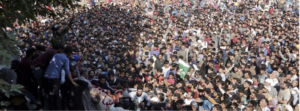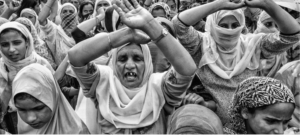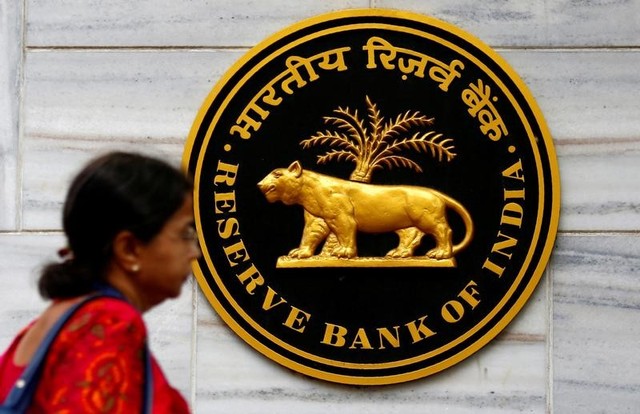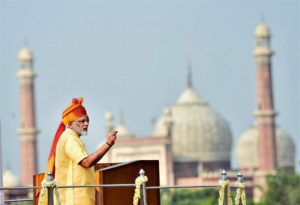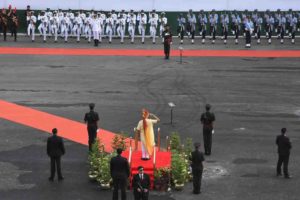A quarter of a century ago, at the formal White House press conference that followed Indian prime minister Narasimha Rao’s one-on-one meeting with President Bill Clinton during his state visit to the United States in April 1994, President Clinton had heaped lavish praise upon India for doing what no other modern country had succeeded in doing before. This was to create a stable nation state using the tool of democracy, instead of War. Clinton said this because it was the very opposite of the way in which nation states had been created in Europe in the tumultuous century that had preceded the signing of the Treaty of Westphalia, in 1648.
Till the advent of globalization, the archetypal European Nation State had hard frontiers, a unitary political structure and a culturally homogeneous population with a single national language. This uniformity had been imposed upon its citizens through a mixture of education, cultural assimilation and ethnic cleansing.
The process had been violent. It had begun with the Hundred years War , the most bloody and ruinous that Europe had experienced till then. It reached its Valhalla in the 31-year period of the 20th century that embraced two world wars, the Russian revolution, the Turkish pogrom of Armenians, and the Holocaust. Altogether, this ”Age of Catastrophe” claimed more than a hundred million lives.
But human perceptions have been slow to catch up with reality. So, even after the second world War the European Nation State remained the only accepted model for a viable modern state. In the Age of Decolonisation that followed, 131 new nations became members of the United Nations. All but a few started out as democracies but only two, Costa Rica and India, succeeded in sustaining and stabilising it.
The similarity, however, ended there: Costa Rica is a very small, unitary State with a population of just over 4 million. India by contrast is the second largest nation in the world, with a population of 1.3 billion, with 12 major and scores of smaller ethno-national groups, most of which have their own language, long histories as independent nations, and strongly defined cultural identities.
Under the sagacious leadership of Mahatma Gandhi, the Congress party was able to fuse them into a single nation because, unlike the majority of the other newly emergent nations, it made no attempt to create a replica of the European Nation State. Instead it celebrated India’s diversity and used democracy and federalism to create unity within it. What emerged after three decades of fine tuning was a “federation of ethnicities” – that the Indian Constitution explicitly describes as a ‘Union of States’ in which each ethno-national group enjoyed an equal place within a framework defined by the Indian Constitution.
The Mortal Threat India Faces
This is the unique achievement that is now under mortal threat. For in the elections to the national Parliament held in 2014, power passed decisively from the Congress party, into the hands of its main rival, the Bharatiya Janata Party (BJP), which considers India’s religious and ethnic diversity to be not its strength but its weakness, and is committed to replacing it with a muscular , hyper-nationalist Hindu Rashtra ( Hindu nation), bound together by Hindutwa ( Hindu-ness) a Hindu cultural identity, in which non-Hindus can be accepted, but never on equal terms with the Hindus.
In contrast to Hinduism, which is less a religion than a way of life and is at least three millennia old, both Hindutva and Hindu Rashtra are synthetic concepts, created only 96 years ago, in 1923. Their progenitor was a Maharashtrian intellectual, Vinayak Damodar Savarkar who passionately believed that the ethnic and religious diversity of India was the main stumbling block to the creation of a revolutionary movement strong enough to force the British out of India.
Savarkar argued in his now famous book, Hindutva, that Hinduism had to develop the cohesion that Muslims all over the world had shown to resist Britain’s abolition of the Caliphate, whose titular head had , for centuries been the ruler of the Ottoman empire. It was the rapid spread of this Khilafat ( opposition) movement among Indian Muslims that gave concrete shape to his concept of Hindutva. The Muslims, he argued, were capable of uniting rapidly to defend an institution located a quarter of a world away that they barely understood, because of the unity their religion gave them. Hindus who had no church, and no clergy comparable to those of Islam and Christianity had no such capability. If they wished to free their motherland from slavery. they needed to develop it
The three essentials of Hindutva, he concluded, were a common nation (rashtra), a common race (jati) and a common culture or civilisation (sanskriti). The impress of European Fascism on his thinking was reflected by the similarity of this slogan with the German Nazi party’s ein volk (one people), ein reich (one nation), ein Fuhrer (one leader). And just as the Nazis decided that Jews could not be a part of this ‘volk’, Muslims and Christians could not belong to the Hindu jati (genus), because their sanskriti (culture) and their prophets originated outside of the Hindu civilisation.
The threat to India arises from the fact that economic globalization has made the European model of the Nation State obsolete. The BJP and RSS’ effort to duplicate it in India has therefore come a hundred years too late. The most they can hope to achieve now is to turn India into an extreme Right wing citadel State. But, as the European experience with German fascism and the disintegration of the Soviet Union has shown, this is foredoomed because it can lead only to war or rebellion, followed by disintegration. Either of these will bring about the end of the great democratic experiment of building a modern nation state through democracy that Gandhi, Nehru and their colleagues in the Freedom movement embarked upon in 1947.
Averting this looming disaster is going to be a Promethean task. It cannot be done by appealing to traditional caste loyalties and deal-based politics to overthrow the BJP any longer. Since the BJP’s challenge is an ideological one, it can be fought only by exposing its hollowness and inherent destructiveness and remind all Indians of true religious and ideological mooring, which is in religious syncretism – the constant effort to create harmony between religions and cultures, in place of conflict.
The Congress’ constant description of itself as a ‘secular’ party has made it an easy target for the votaries of Hindutwa, because of the aura of irreligiosity that surrounds the word. The guiding philosophy that has underpinned not only the modern Indian state but all major empires in India’s history, and from which India’s comfort with ethnic and religious diversity springs, is not secularism or even pluralism, but religious syncretism. This springs from the philosophy and practice of ‘Dharma’.
Dharma -the antidote to Hindutwa
Dharma is the original faith of Vedic India. There is no reference in the Vedas, the oldest texts of the Indo-Aryan civilization, to a Hindu Dharma, because the word ‘Hindu’ was coined by the Persians 3,000 years ago to describe the land of the Sindhu ( I.e Indus) river. It was brought to India from Persia more than two millennia later by the first Muslim invaders who came through Afghanistan and Persia.
Dharma was not a religion in the modern, exclusivist, sense of the word, because the Messianic religions that are now the subject of most discourses on religion had not even been born when the word was coined. Dharma prescribed the right way of living: it dwelt at length on how people needed to relate to each other and to the wider world and the cosmos that surrounded them.
The Rig veda differentiates between different forms of dharma, such as prathama Dharma ( the first duty), Raj Dharma (the duties of the King to his subjects) and Swadharma ( our duty to ourselves). But every one of these centers around the concept of human duty, which is “to uphold, to support, to nourish”.
“Dharma” was the word Gautama Buddha used to describe his sermons on the four noble truths and the eight-fold path. Western students of comparative religion, have done Buddhism a disservice by presenting it as a new religion, because this has made it one among several religions, including the three Messianic religions, Judaism, Christianity and Islam.
Buddha’s use of the Vedic term suggests that he considered himself to be a social reformer and not a prophet. What he had rebelled against was the corruption of Dharma, and the growth of Adharma. These were caused by self-absorption, avarice, expensive and impoverishing ritual, and Brahminical control. Buddhism was, in fact, the first great recorded rebellion against organised religion in human history. Buddha’s use of the Vedic term suggests that he considered himself to be a social reformer of Dharma ( the Buddhist Dhamma) and not a prophet founding a new religion.
A critical difference
Describing Buddhism as one of several prophetic religions, as most students of comparative religion in the west habitually do, has obscured a critical difference between Hinduism, Buddhism and other mystical religions on the one hand, and the Messianic ones—Judaism, Christianity and Islam, on the other. Messianic religions have to be professed. Belonging to the latter requires a profession of faith in it and a repudiation of other faiths. It is a surrender of oneself to the ‘true’ God, and its reward is the possibility of gaining absolution for one’s sins through repentance, in this life.
Mystical faiths, of which Dharma is the oldest, have to be lived. Only virtue in this life can gain the soul freedom from the chain of rebirth. Dharma requires no profession of faith, no submission to a single prophet. And it offers no easy absolution from sin. It is the Hindu way of referring to Buddhism, as Bauddha Dharma, and the remark that Hindus frequently make even today – “yeh mera Dharma hai” ( This is my duty) that capture its essence.
The idea of Religion as a set of beliefs that have to be practiced and not merely professed is not limited to Hinduism and Buddhism, but has managed to carve out a niche in Islam and Christianity as well. In the 11th and 12th centuries, it found a home in a Christian sect called the Cathars (or Albigenses) in southern France and Spain, and in some branches of Shia Islam such as the Alawis of Syria, Iraq and Turkey.
Not surprisingly, both sects have been treated as heretical apostates by the clergy of orthodox Christianity and Islam. In AD 1200, Pope Innocent III launched a little known Fourth Crusade against the Cathars, and instructed the knights and Barons who joined it to kill all they met without mercy, and leave it to God to sort out the heretics from the true believers. As for the Alawis, the most recent of innumerable attacks upon them in Syria has still not ended.
But in the sharpest possible contrast, the encounter between Dharma and Islam in India has been peaceful. Dharma’sfirst encounter with Islam occurred when Arab traders came to Gujarat and built mosques there in the 8th and 9th centuries. Not only did this not spark religious conflict but, as contemporary Jain texts recorded two centuries later, when an Afghan invader, Mahmud of Ghazni, attacked the famed Somnath Temple ( Temple of the Moon God) in Gujarat, the Arabs who had by then been living there for generations, joined in the defence of the temple and died to protect it. The fact that Somnath was a Hindu temple did not matter to them. It had to be defended because it was important to the Hindus among whom they lived.
The second, more prolonged, interaction between Dharma and Islam occurred after the establishment of the Delhi Sultanate by another Afghan invader Muhammad Ghori, in 1193 AD. The period that followed is the one that the RSS would like to erase from Indian memory, if not from history.
But it was a period in which there was an unprecedented flowering of art, music and literature. It was the time of Amir Khusro, the first Indian pet who wrote in Persian. It was the time when Indian and Persian music and dance fused to create a distinct new Genre, the khayal gayaki and the Kathak dance. It was the period during which the delicate penmanship of Persian miniature painting fused with the vivid colours of Hindu art to create a profusion of Moghul, Rajput, Kangra, Basohli and other schools of miniature painting in India. It was the time when the Indo-Islamic architecture that has given the world wonders like the Taj mahal, and Humayun’s Tomb, was born.
Hindutva’s selective memory
The ideologues of Hindutva ignore all this and prefer to dwell on the defeat of the Rajputs, the destruction of temples and the conversion of large numbers of Hindus to Islam during this period. This is a manufactured litany of defeat, that they use to fan hyper-nationalism, Hindu religiosity and hatred of the Muslims.
But here too, their ‘memory’ is selective and distorted. The Rajputs, who then ruled most of north India were ,admittedly, driven into the wilds of Rajasthan. But their defeat arose from the superior military technology of the invaders — such as the superiority of cavalry over elephants, and of archers over infantry – and not from any innate superiority of the (Muslim) fighters. On the contrary, the conquerors recognised the valour of the Rajputs and quickly inducted them into their armies.
The votaries of Hindutva harp endlessly about the damage the Muslim invaders did to the Hindu polity and society, but they again choose to ignore the fact that the same Muslim dynasties saved India from the greatest scourge of the Middle Ages – the Mongol invasions that ravaged Europe. Like other impoverished groups from the Asian steppes, the Mongols first tried to invade India. Their first foray, in 1243, took the Delhi Sultanate by surprise and the Mongols were able to come all the way till Lahore, now Pakistan’s most beautiful city, and sack it to their leisure.
But that was the last time they were able to enter the plains of India. Ghiyasuddin Balban, the ruler in Delhi at the time, created a standing army – India’s first – built a string of forts along the border and prevented all subsequent invaders from getting far into the plains of Hindustan. After his death, another warrior king of the Delhi Sultanate, Alauddin Khilji, inflicted two successive defeats on them in 1304 and 1305, with such great slaughter that they turned towards Europe and never returned.
Temples were admittedly destroyed, and precious art, sculpture and architecture irretrievably lost, but the motive of the invaders, like that of invaders everywhere else in history, was pillage not forced conversion to Islam. All but a fraction of the conversions that took place in the next 400 years were voluntary.
The converts came from the lower Hindu castes. They converted because Islam offered an escape from the iniquities of caste – in much the same way as Buddhism had done two thousand years earlier, and as the Bhakti ( devotion) anti-Brahmin movement in south India had been doing since the seventh century, well before the arrival of the Muslims. Far from being a blot on the conquerors, these conversions were an impeachment of the Brahmanical, temple-centred Hinduism from which they had been systematically excluded.
Reconciliation between Hinduism and Islam
In northern India, the encounter between Islam and Hinduism proved beneficial to both in important ways that the Sangh parivar prefers not to remember. In Hinduism, it weakened the link between religion and the state by cutting off the single most important source of patronage to the temples. As state patronage dwindled, Brahmins, who had previously flocked to the peeths and mutts were forced to remain in their villages and tend to the spiritual needs of the villagers. The emphasis in their functions, therefore, shifted from presiding over elaborate temple rites to providing guidance on the issues the villagers faced in their everyday lives. The importance of ritual in Hinduism therefore declined and that of Dharma increased.
Hinduism met the challenge from Sufi Islam by disseminating the core ideas of Dharma, already espoused and rejuvenated by the Bhakti movement, through the literature, poetry and song of Tulsidas, Surdas, Kabir, Rahim, Mira Bai, Tukaram, Chokhamela and a host of lesser-known poets, bards and singers. The interaction between the two made Hinduism accessible and mellowed Islam further, to the point where except for scripture, little remained of what had divided the one from the other. No couplet I know captures this more succinctly than one by Kabir that I learned as a child and have never forgotten:
Moko kahaan dhoondhate bande, Mai to tere paas me;
Na Mai Mandir, na Mai Masjid, naa Kaaba Kailash me.
(Where dost thou seek me oh devotee, for I am right beside thee; Not in a temple, nor in a mosque, not at the Qaaba, nor on Mount Kailash, shalt thou find me).
This profound reconciliation between Hinduism and Sufi Islam is perhaps best reflected in the writings of Guru Nanak and the other gurus of Sikhism. And it was not confined to the villages. It was codified by no less august a person than Emperor Akbar as the Din-e-Ilahi, the religion of God, at the height of the Moghul empire. Some British historians have hailed it as an attempt at founding a new religion based on universal tolerance. Others have dismissed it as a religion that never had more than 19 followers.
In fact, Akbar had no such intention. The Din-e-Ilahi was no more than a distillation of what today’s corporate world would call “current best practices” of the heterodox population of India. It propagated sulh-i-kul – universal peace – and urged ten virtues upon the realm. Among these were: liberality and beneficence; forbearance from bad actions, repulsion of anger with mildness; abstinence from worldly desires; frequent meditation on the consequences of one’s actions and “good society with brothers so that their will may have precedence over one’s own”, in short, putting the well-being of one’s fellows ahead of one’s own.
Akbar’s goal was not proselytization. Unlike the great Mauryan emperor, Ashoka’s Buddhist edicts of 1800 years earlier, Akbar issued no edicts. Nor did he create a religious police to oversee their observance.
The significance of the Din-e-Ilahi lies in what it did not prescribe: It did not ascribe primacy to Islam, and it did not give a special place to Muslim clergy within the structure of the state. Instead, it declared emphatically that “he (the emperor, i.e. the state) would recognise no difference between [religions], his object being to unite all men in a common bond of peace”. The entire document was, therefore, a restatement of Dharma in a contemporary form. If any “ religion “ can claim to have emerged the victor in the grand ideological battle that ensued after thearrival of Islam in India, it is Dharma.
Among Hindus the practice of Dharma has been – and remains – sullied by its endorsement of the notion of ritual purity and pollution that is associated with caste. But its core idea, that true religion is not what we preach but what we practice, has remained the driving force behind all movements for religious reform from the Buddha till the present day. It is what Swami Vivekananda electrified the ‘Parliament of Religions of the World’ in Chicago in 1893 with, by explaining that Hinduism does not merely tolerate, but accepts, all the great religions of the world because they are like different paths up the same mountain, or different rivers that flow into the same sea.
Even the blood-soaked partition of India and Pakistan in 1947 did not kill off the syncretic impulse in Islam. It has led to a sustained study of the writings of Dara Shikoh, the grandson of Akbar, and his successor Shah Jahan’s eldest son and heir apparent in Pakistan. Dara Shikoh was a scholar of Sanskrit and translator of the Bhagavad Gita, one of Hinduism’s holiest texts. He had made no secret of his fascination with Din-e-Elahi, and of his intention to propagate it throughout his realm, before his life was cut short by his youngest brother, Aurangzeb.
In 2010, the noted Pakistani playwright, Shahid Nadeem, wrote a play, ‘Dara’, that highlighted his syncretism, as a protest against the rampant Islamic sectarianism that Partition had unleashed upon Pakistan and was, even then, tearing it apart.
Three years later, two Pakistani historians from GC University, Faisalabad, published a peer-reviewed paper in the International Journal of History and Research titled ‘Dara Shikoh: Mystical And Philosophical Discourse‘, which highlighted his belief that “the mystical traditions of both Hinduism and Islam spoke of the same truth.”
This is the awe-inspiring syncretism of religion in the land of Dharma. It is what has made Indian Muslims virtually immune to the lure of the Islamic State in Syria and Iraq: Against the 27,000 to 31,000 Europeans who joined it, the number of Indian Muslims was only 106. Of these, only three went directly from India. The rest were recruited while they were migrant workers in the Gulf.
This is the awe-inspiring syncretism of India that the votaries of Hindutva and Hindu Rashtra are bent upon destroying . Hindutwa is therefore the complete antithesis of dharma.
From Where Has Hindutwa emerged?
In the 1920s, the desire to militarise Hinduism could perhaps have been condoned, for it was a counsel of despair. The Congress was still only a middle-class debating society, Mahatma Gandhi’s doctrine of satyagraha (passive resistance in order to paralyse government)was still largely untried, and the British had taken to shooting down or hanging freedom fighters after labelling them terrorists. But the last shred of this justification lost its raison d’etre when India gained its freedom. For the creation of Pakistan had fulfilled at least one of the goals of the RSS – it had rid India of all the Muslims who did not accept that they were part of Savarkar’s ‘Hindu sanskriti’.
The one-third who stayed in India had therefore declared their alleigiance to India with their feet. So what fuelled the frantic rage against Partition that the RSS vented in immediate aftermath of Independence? Why did they rejoice openly when Mahatma Gandhi was assassinated and lionize his assassin, Nathuram Godse? And what has made them continue to demonise Indian Muslims after they had ceased to be a threat to “Hindu” India?
The explanation is that the RSS’s goal was not simply to oust the British from India, but to take their place in order to create a Hindu India moulded to fit their image of Hindu Rashtra.
Today, the Sangh parivar is trying to pass off Savarkar and Keshav Baliram Hedgewar, the founder of the RSS, as freedom fighters. But the biographer of Hedgewar, and some of the remarks of his successor Golwalkar show, from the Dandi Salt March in 1929 till Gandhi’s Quit India call in 1940, the RSS stoutly opposed every attempt to secure freedom through the Gandhian way of satyagraha (passive non-cooperation), and even offered its cohorts to the government to act as civil guards to quell the unrest that Gandhi’s call would generate.
To the RSS, freedom was less important than power. It needed more time to create the Hindutva legions with which it hoped to storm to power. And as with fascism in Europe, it required an enemy that it could persuade people to hate and fear, to facilitate their creation.
Caught by surprise by the Partition, which Mountbatten announced only in March 1947, the RSS made an attempt, nonetheless, to seize power in the wake of the turmoil unleashed by it and the assassination of Mahatma Gandhi. That got it banned for several years, but the seizure of power remained its unswerving goal through all its subsequent vicissitudes.
What happens now?
The BJP’s second victory in 2019, has removed all the political and constitutional hurdles to achieving the goal that the RSS had set itself in 1923. Narendra Modi has brought it to power on a wave that will almost certainly sweep through the state assembly elections as well, and give it the majority in the upper house of parliament that it needs to change the constitution of India. But he, and the RSS are in a hurry and have little appetite for the debates that wll rage in parliament and civil society when the government presents bills for radically altering the structure of the constitution. As a result it is resorting to legal sleight of hand to start ethnic cleansing, and to dissolve the constitutional safeguards that protect India’s ‘federation of Ethnicities”.
Ethnic cleansing began in earnest within weeks of its coming back to power. The government finalised a National Register of Citizens in Assam, that left out 1.9 million persons who had lived in the state with their families and children for five and more decades. To house them ‘temporarily’ till they are repatriated to Bangladesh or elsewhere, the government is building “detention” camps for them all over Assam, and has issued a directive to the administrative heads of all of India’s 724 districts to chalk out sites for building similar camps in their districts when the need for them arises.
That the intended targets are Muslims immigrants from Bangladesh became apparent when the BJP government in Assam asked for an amendment to the citizenship rules that would allow it to limit the externment only to Muslim immgrants from Bangladesh.
The assault on India’s religious syncretism has been launched in the one place where it had continued to flourish till well after Partition, and where it still survives today. This is the state of Jammu and Kashmir. On August 5, the government used a constitutional sleight of hand to dissolve the statehood of Kashmir, and turn it into a “union territory” and administer it directly from Delhi, without any reference to its legislature or people.
The closest parallel in history to BJP’s victory this year is Hitler’s return to power in March 1933. The Nazi campaign too was based upon hatred and paranoia. Its targets were principally the Jews, but also the Gypsies whom they considered another inferior, polluting, race and the Communists.
Like the BJP today, the Nazis took advantage of the collapse of the German economy after the Wall Street Crash of 1929 to seize power in 1930 with 33% of the vote. Three years later, their hate rhetoric had pushed up their vote to 43%. Within days of the January 1933 results, its storm troopers duped a Communist sympathiser into setting the German parliament building on fire and helped him do it. In the anti-Communist hysteria that followed, Hitler was able to win the March 1933 elections, persuade President von Hindenburg and the German parliament to pass an enabling act giving him extraordinary powers, declare him hancellor for life and thus destroy the Weimar Republic. His storm troopers then systematically attacked Jews, Gypsies and Communists, set up internment camps and when these became too expensive to maintain, sent them to the gas chambers.
The Nazi experiment ended in the defeat, destruction and vivisection of pre-war Germany. The Hindutwa experiment has just begun, and we cannot predict with certainty where it will end. But the future looks grim. The Modi government has another four years and eleven months to go. Only an opposition,in parliament, and civil society, that rediscover Dharma, and pits it against Hindutwa, has any chance of stopping the rush to disaster.
Read More


